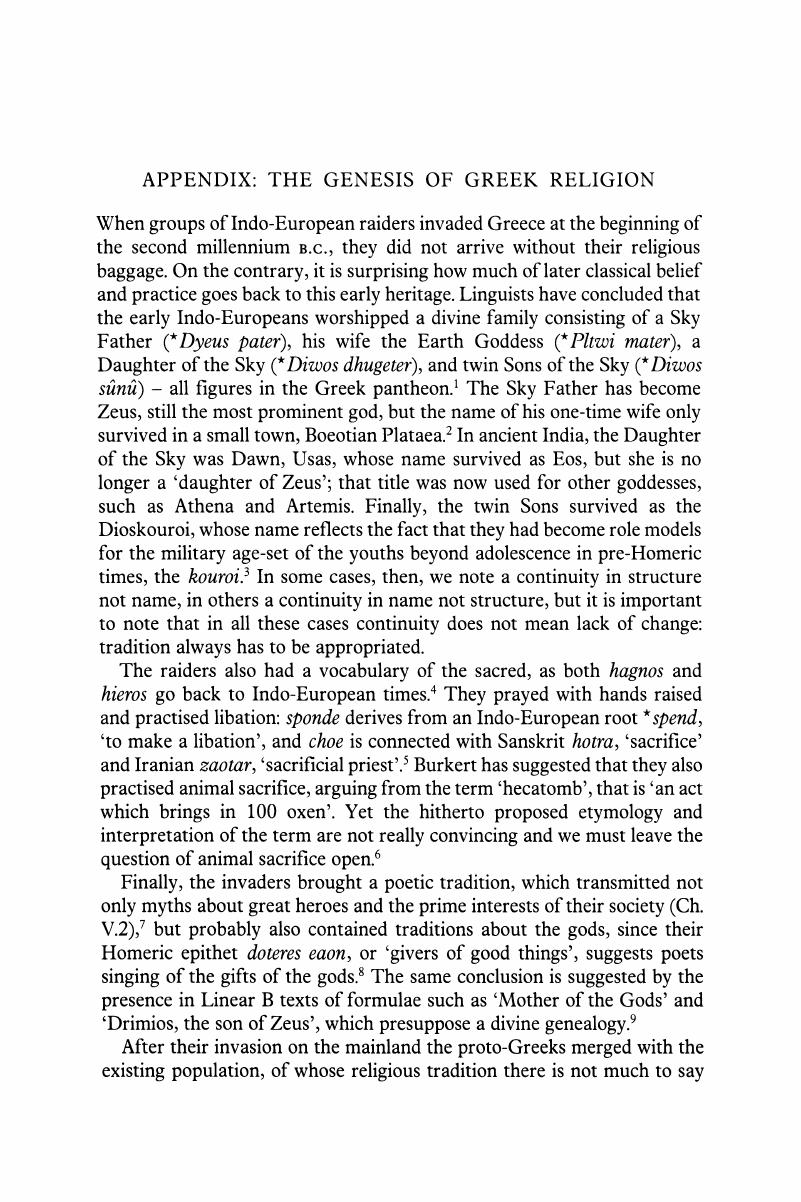No CrossRef data available.
Article contents
Appendix: The Genesis of Greek Religion
Published online by Cambridge University Press: 05 February 2016
Abstract

- Type
- Other
- Information
- Copyright
- Copyright © The Classical Association 1999
References
Notes
1. Cf. Euler, W., ‘Gab es eine indogermanische Götterfamilie’, in Meid, W. (ed), Studien zum indogermanischen Wortschatz (Innsbruck, 1987), pp. 35–56 Google Scholar; Dunkel, ‘Vater Himmels Gattin’.
2. Burkert, Structure and History, pp. 132–4.
3. The importance of this age-set is already waning in Homer, cf. Hoekstra, A., Epic Verse before Homer (Amsterdam, 1981), pp. 76–81 Google Scholar.
4. Hieros: Ramón, J. L. García, ‘Griechisch hieros und seine Varianten, vedisch isirá ’, in Beekes, R. et al. (eds), Rekonstruktion und relative Chronologie (Innsbruck, 1992), pp. 183–205 Google Scholar; add. Bader, F., Studi Class. e Or. 41 (1991), 76–83 Google Scholar. Hagnos: Burkert, GR, p. 17.
5. Prayer: Dunkel, G., ‘Periphrastica Homerohittitovedica’, in Brogyanyi, B. and Lipp, R., Comparative-Historical Linguistics: Indo-European and Finno-Ugric (Amsterdam, 1993), pp. 103-18CrossRefGoogle Scholar. Libation: E. Polome, ‘Der indogermanische Wortschatz auf dem Gebiete der Religion’, in Meid, Studien, pp. 201–17, esp. 208.
6. Burkert, GR, p. 18; contra, Campanile, E., ‘Riflessioni su hekatómbe ’, in Studia linguistica . . . dedicati alla memoria di Enzo Evangelisti (Milano, 1991), pp. 149-54Google Scholar.
7. As is suggested by the formulae kleos aphthiton, ‘imperishable fame’, and klea andron, ‘glories of men’: see most recently C. Watkins, in Polomé, E. and Winter, M. (eds), Reconstructing Languages and Cultures (Berlin and New York, 1992), pp. 411-16CrossRefGoogle Scholar; E. Campanile, ‘Zur Vorgeschichte der idg. Dichter-formeln’, in Brogyanyi and Lipp, Comparative-Historical Linguistics, pp. 61–71.
8. J. B. Hainsworth on Od. 8.325 (comparison with the Rig-Veda suggests that this is an extremely old formula); Ruijgh, C. J., Mnemosyne IV 44 (1993), 539 Google Scholar.
9. Graf, F., ‘Religion und Mythologie im Zusammenhang mit Homer’, in Lataczs, J. (ed), Zweihundert Jahre Homer-Forschung (Leipzig and Stuttgart, 1991), pp. 331-62Google Scholar, esp. 350f.
10. Still largely supported by Burkert, GR, p. 21, but see now especially the studies by Hägg, R., ‘Mycenaean Religion: the Helladic and the Minoan components’, in Davies, A. Morpurgo and Duhoux, Y. (eds), Linear B: a 1984 survey (Louvain, 1985), pp. 203-25Google Scholar and ‘The Role of Libations in Mycenaean Ceremony and Cult’, in Hägg/Nordquist, Celebrations of Death and Divinity, pp. 177–84; W.-D. Niemeier, ‘Cult Scenes on Gold Rings from the Argolid’, ibid., pp. 165–70.
11. See now Marinatos, Minoan Religion.
12. Cf. Burkert, Orientalizing Revolution, pp. 46–53; add Lissarrague, F., L’autre guerrier (Paris, 1991), pp. 55–69 Google Scholar.
13. For this influence see now Burkert’s Orientalizing Revolution. Not all of Burkert’s parallels are persuasive, though. For example, it seems unlikely that the myth of the Seven Against Thebes derived from the Orient, cf. Singor, H. W., ‘The Achaean Wall and the Seven Gates of Thebes’, Hermes 120 (1992), 401-11Google Scholar.
14. See now also Burkert, , ‘The Formation of Greek Religion at the Close of the Dark Ages’, St. It. Fil. Class. 85 (1992), 533-51Google Scholar.


